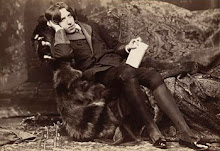 “I will stay with you one night longer,” said the Swallow, “but I cannot pluck out your eye. You would be quite blind then.”
“I will stay with you one night longer,” said the Swallow, “but I cannot pluck out your eye. You would be quite blind then.”“Swallow, Swallow, little Swallow,” said the Prince, “do as I command you.”
So he plucked out the Prince’s other eye, and darted down with it. He swooped past the match-girl, and slipped the jewel into the palm of her hand. “What a lovely bit of glass,” cried the little girl; and she ran home, laughing.
Then the Swallow came back to the Prince. “You are blind now,” he said, “so I will stay with you always.”
“No, little Swallow,” said the poor Prince, “you must go away to Egypt.”
“I will stay with you always,” said the Swallow, and he slept at the Prince’s feet.
The Happy Prince by Oscar Wild
 e
eWe receive a March talisman from Romania along with a kind invitation for a visit.
In Greece we also twist a red and a white piece of string and make a bracelet-talisman for children to wear until the first sparrow appears. A sweet way to welcome spring...
Από τη Ρουμανία μας ήρθε ένας "Μάρτης" μαζί με μια ευγενική πρόσκληση στην Ταργκοβίστε. Τα κοινά μας έθιμα μας παρέπεμψαν πάλι στο τρυφερό παραμύθι που μας απασχόλησε πριν από καιρό, τον Ευτυχισμένο Πρίγκιπα του Όσκαρ Ουάιλντ, όπου το χελιδονάκι γίνεται ο βοηθός του πρίγκιπα-αγάλματος για να απαλύνει τον ανθρώπινο πόνο, και τελικά, χάνει την ευκαιρία να αποδημήσει στην Αίγυπτο και πεθαίνει στα πόδια του φίλου του.
Why does the swallow have a forked tail?
Legend has it that during Constantinople’s siege in 1453 (not far from Dracula’s era), a swallow flew from the city to seek help, but was attacked by the Turks who cut his tail in two, and wounded him in the neck, which explains the red colour around his beak. From our library book “Birds that live near us” by biologist Costas Vassilakis, Livanis pbl, Athens, 2002, ISBN 960-14-0534-8
Γιατί το χελιδόνι έχει διχαλωτή ουρά;
Γιατί σύμφωνα με το θρύλο που διαβάσαμε στο βιβλίο του Κώστα Βασιλάκη "Τα πουλιά που ζουν πλάι μας", Λιβάνης, Αθήνα 2002, ISBN 960-0534-8, το σπάθισε Οθωμανός ενώ έβγαινε από την Πόλη να ζητήσει βοήθεια, το 1453. Έτσι εξηγείται και το κόκκινο χρώμα γύρω από το ράμφος του.

















No comments:
Post a Comment